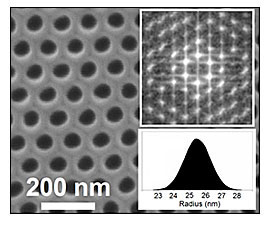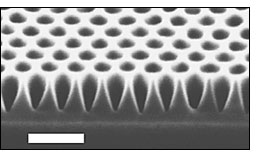PROVIDENCE, R.I., Nov. 21 -- Silicon has made its way into everything from computers to cameras. But a silicon laser? Physically impossible -- until now. 
Since the creation of the first working laser -- a ruby model made in 1960 -- scientists have fashioned these light sources using substances from neon to sapphire. Silicon, however, was not considered a candidate. Its structure would not allow for the proper lineup of electrons needed to get this semiconductor to emit light.
But a trio of Brown University researchers, led by engineering and physics professor Jimmy Xu, has made the impossible possible, by creating the first directly pumped silicon laser. By drilling billions of holes in a small bit of silicon using a nanoscale template, they changed the atomic structure of silicon itself. The result: weak but true laser light. Results are published in the online edition of Nature Materials.

The "mask" used to drill the holes in the silicon (Photos: Xu Laboratory, Brown University)
The feat is an apt one for Xu, whose Laboratory of Emerging Technologies is also known as the "laboratory of impossible technologies."
Xu said that when lasers were invented, they were considered a solution looking for a problem. Now lasers are used to power CD players and barcode scanners, and they can cut everything from slabs of steel to delicate eye tissue during corrective surgery.
"A very new discovery in science eventually finds an application," Xu said. "It will just take years of work to develop the technology."
Light emission from silicon was considered unattainable because of silicon’s crystal structure, and electrons necessary for laser action are generated too far away from their "mates." Bridging the distance to make the atomic connection would require just the right "matchmaker" phonon arriving at precisely the right place and time.

The reconfigured material
In the past, scientists have chemically altered silicon or smashed it into dust-like particles to generate light emission. But more light was naturally lost than created. So Xu and his team tried a new way to tackle the problem. They changed silicon’s structure by removing atoms.
This was accomplished by drilling holes in the material. To get the job done, the team created a template, or "mask," of anodized aluminum. About a millimeter square, the mask features billions of tiny holes, all uniformly sized and exactly ordered. Placed over a bit of silicon then bombarded with an ion beam, the mask served as a sort of stencil, punching out precise holes and removing atoms in the process. The silicon atoms then subtly rearranged themselves near the holes to allow for light emission.
The new silicon was tested repeatedly over the course of a year to ensure it met the classical criteria of a laser, such as threshold behavior, optical gain, spectral line-width narrowing and self-collimated and focused light emission.
Xu credits Sylvain Cloutier, a PhD student and the Nature article’s first author, with the success of the experiment. "The whole thing started with my hunch that silicon could be altered this way and might surprise us with new behavior," Xu said. "But Sylvain took the idea and ran. He conducted the first tests and set up the measurements. And he was skillful and careful enough to catch the first faint bit of laser light from the nanostructured silicon."
Cloutier said, "I felt thrilled and really curious when I first observed the light emission, but I also knew there would be a lot of work ahead before demonstrating laser action."
Postdoctoral research fellow Pavel Kossyrev independently verified the process and the results.
The Defense Advanced Research Projects Agency and the Office of Naval Research funded the work. Xu also received support from the John Simon Guggenheim Memorial Foundation, and Cloutier received support from the Natural Sciences and Engineering Research Council of Canada.
For more information, visit: www.brown.edu